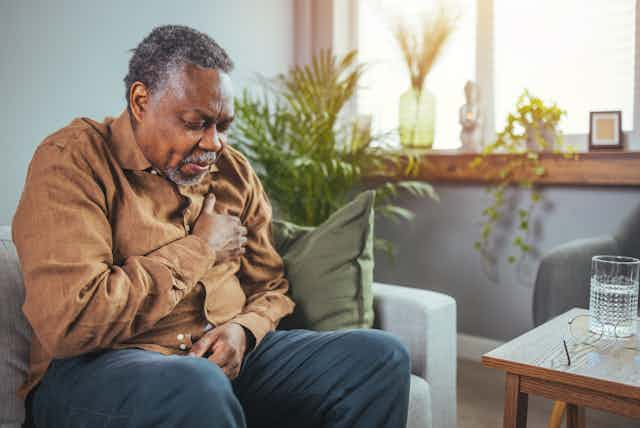Your chest tightens, like an elephant is sitting on it. Pain streaks down your arm and you break out in a cold sweat. You feel light-headed and you’re pretty sure you’re having a heart attack. So when do you call an ambulance?
You might think the answer is easy: straight away, right? It’s well known getting the right medical help early when you’re having a heart attack can be a life or death decision.
For many people from CALD (culturally and linguistically diverse) communities, however, the answer might be: hours and hours after the first symptoms strike. Our research has shown many migrants don’t seek help straight away.
Why do so many migrants wait so long to seek help or go to hospital after chest pains? And what can we do about it?
What we know so far
Our previous research, based on a study involving more than 600 patients who presented at a hospital with chest pain, looked at how long they delayed seeking medical help and how long they delayed going to hospital.

We found a median pre-hospital delay time of six hours for Sub-Saharan African migrants. This compared with an overall median pre-hospital delay time of 3.7 hours across the whole group.
Importantly, decision time to seek help takes up to 83% of pre-hospital delay in migrant patients, compared to only 48% for Australian-born patients.
In other words, the delay was caused by the patient’s decision to wait before seeking help (as opposed to, say, traffic problems or an ambulance taking too long to arrive).
The median “decision time” was:
- 4.5 hours for migrants from Sub-Saharan Africa
- 4.1 hours for migrants from the Middle East
- 3.9 hours for migrants from Southeast Asia
- 3.5 hours for migrants from Southern and Central Asia.
By contrast, the median decision time for Australians was 1.5 hours.

Why might some migrants delay seeking help for chest pains?
Our subsequent research has shown certain factors may influence how long a migrant waits to seek help after chest pains first appear. These include things such as:
- their ability to speak English
- the type of visa they were on
- whether or not they have Australian permanent residency.
Non-English speaking migrants are more likely to wait hours before seeking help, while migrants from English-speaking backgrounds sought medical care more quickly.
People on skilled visas are much more likely to take more than an hour before deciding to go to hospital, as are people on family visas reuniting them with relatives already in Australia.
And once migrants do decide to seek medical help for chest pain, they often did not call an ambulance straight away. Rather, they often first opted to visit their family doctor or attempted to drive themselves to hospital. We found this was more common among migrants with limited English.
Those on humanitarian visas (refugees) tended to seek help sooner. This group is much more likely to have access to social supports and welfare services though special programs such as the Status Resolution Support Services or state-based refugee health services.
Migrants working in Australia on skilled visas, by contrast, may delay seeking help because they have no health insurance, are worried about their jobs or fear hefty ambulance fees or medical costs.
The video below features some of our interviewees explaining their thoughts on how they would respond if experiencing chest pains. Their faces are not shown to protect their identities; instead we used the image of a teddy bear because our research came to be known as the “Time, Ethnicity and Delay” study, or TED for short.
One migrant chef we spoke to experienced chest pain and dizziness but kept working because he was afraid he might lose his job. He worried calling an ambulance would land him with a bill he couldn’t afford to pay.
Many people on family visas, particularly older migrants with limited English, worried about how to explain chest pain in an unfamiliar language and if they would be able to understand the doctor.
They often relied financially on younger family members and wanted to avoid being a “burden” to them by seeking help for their chest pain.
What can be done?
Our long-running research, which involved consultation and collaboration with stakeholders and migrant communities in Australia, has revealed some startling inequities.
Some key interventions, however, would make a big difference.
These include:
incorporating cultural and social factors into public campaigns and health promotions. This could include health promotion programs for specific cultural groups, and ensuring we have materials and outreach efforts in languages other than English
creating health-care apps in different languages to target people who feel more comfortable browsing an app for information than, say, making a phone call
improved cultural competence in health-care systems and incorporating these findings into health-care training
better education for CALD communities about how the health system works, especially soon after they arrive in Australia
greater awareness among health-care professionals of this pattern of delayed help-seeking by many migrants
targeted funding for research addressing the health inequities faced by disadvantaged populations
evaluating how access to key social security services is putting migrant lives at risk.
This final point is crucial. Newly arrived migrants may face a wait of between two and four years (depending on when they arrived) before they can fully access services such as the Commonwealth Seniors Health Card, the Low Income Health Care Card and unemployment benefits.
These long waiting periods widen the gap and worsen the health inequities in our society.

